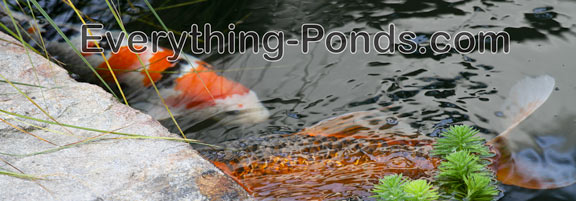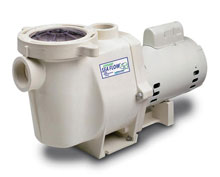
Fish Pond Pumps
There are many types, sizes and brands of fish pond pumps available. At first the many choices may seem confusing. However with a little research and knowledge, the list of possible choices can easily be narrowed down to a single product that will match your needs.
Looking for a Pump? See all our Pumps for Sale Here.
Price and Quality
Goldfish and koi both rely on a healthy pond ecosystem to survive. In nature, a natural pond or stream is able to constantly renew itself with fresh water, while flushing contaminants and excess nutrients out. With a man made pond, the pumping and filtration systems combined are meant to mimic the forces at work in a natural pond. In order to maintain a proper balance, the pump and filter MUST be running 24 hours a day. If the pump were to ever shut off, ammonia levels could become toxic quite quickly, endangering the lives of your goldfish or koi. Because of this, the pump isn't something that you want to go cheap on to save a few dollars. Be sure to purchase a quality pump from a well known pond brand that can be trusted to run 27-7, 365 days per year.
Size of Fish Pond Pump
We usually recommend turning over the entire contents of your pond every hour, as a minimum. What this means is that the full volume of your pond should pass through the pump each hour. For example if a pond is 3000 gallons, a 3000 gph (gallon per hour) pump would pump the entire pond in one hour. However, it's important to realize that any fitting, bends or rises in elevation in the pumping system will reduce the efficiency of a pump. For example, if a fish pond pump is able to achieve 3000gph under optimal conditions, in a real life scenario, it may be reduced to something like 2000gph once it's installed. These forces are collectively known as 'head pressure'. Please see our page on calculating pond head pressure for more information.
External or Submersible
As the names imply, submersible fish pond pumps work by being submerged in water as they pump, and external pumps sit outside the body of water, using an intake pipe or hose to draw water into the pump. In real-world pond installs, both systems are used, and work well for their intended use. Submersible pumps are good for situations where space restraints are not an issue since the entire pump must fit inside the area to be pumped from. For example, to draw water through a skimmer, the submersible pump must be placed directly inside the skimmer, which may or may not fit depending on the size of the skimmer and the size of the pump. Submersible pumps are also quite easy to install which is a plus. To read more about the differences, please see our pages on submersible pumps and external pumps.
If you have a question about what fish pond pump would be right for you, please feel free to contact us!


